Tom's Guide Verdict
The Asus Zen AiO Pro offers speedy performance, discrete graphics and a RealSense camera within a stunning design.
Pros
- +
Slick design
- +
Gorgeous 4K display
- +
Strong CPU and graphics performance
- +
USB Type-C
- +
RealSense Camera
Cons
- -
Dimmer display than competitors'
Why you can trust Tom's Guide
The Asus Zen AiO Pro beats the iMac at its own game. This $1,899 all-in-one's svelte design ($1,499 as configured at Microsoft) will please fans of Apple's iconically slim desktop. But with a touch-ready 4K display, an Intel RealSense 3D camera and USB Type-C support, the Zen does a lot of neat things Apple's all-in-one doesn't. Factor in a speedy 6th-generation Intel Core processor and discrete Nvidia 960M GPU graphics suited for mainstream gaming, and the Zen AiO Pro is one of the best overall all-in-ones available.
Design
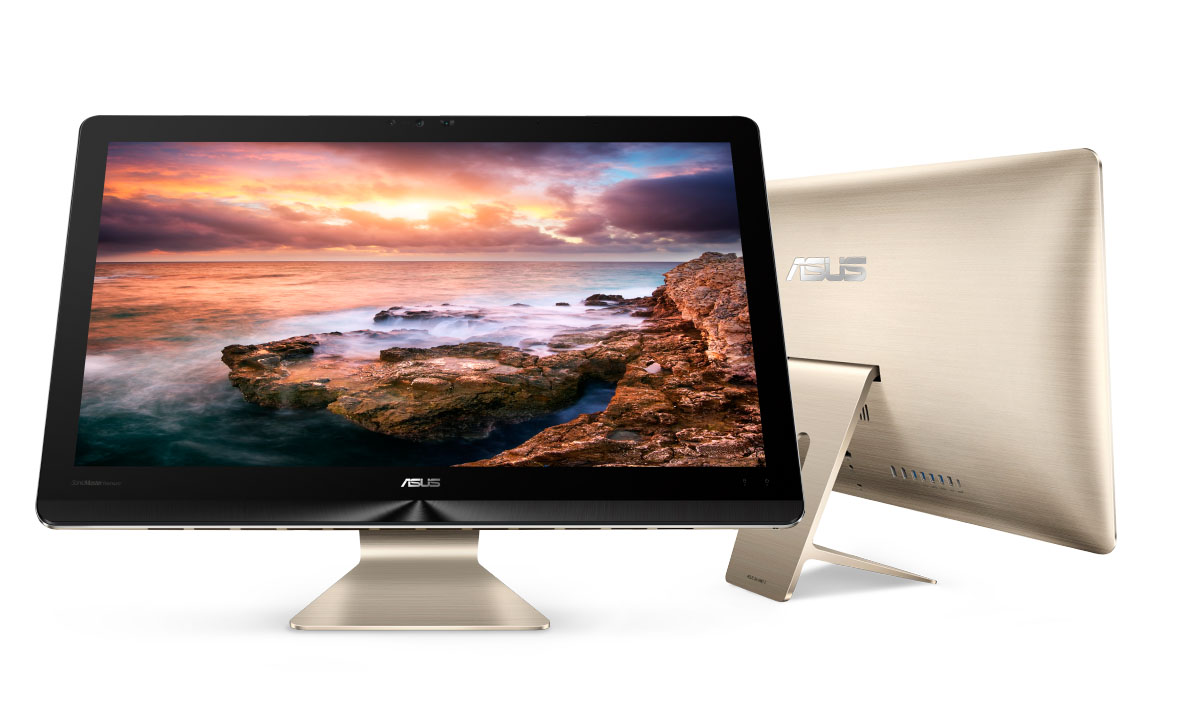
The Asus Zen AiO is on the short list of all-in-one computers you'll actually want to show off to your friends. This slick desktop takes more than a few design cues from Apple's iMac, from its slim, silver display and L-shaped stand all the way down to its near-identical layout of neatly positioned ports in the rear. However, with a shiny Asus logo on the rear and a brushed-aluminum finish (gold is also available) that's a bit darker than that of Apple's computer, the Zen has enough small touches to stand out on its own.
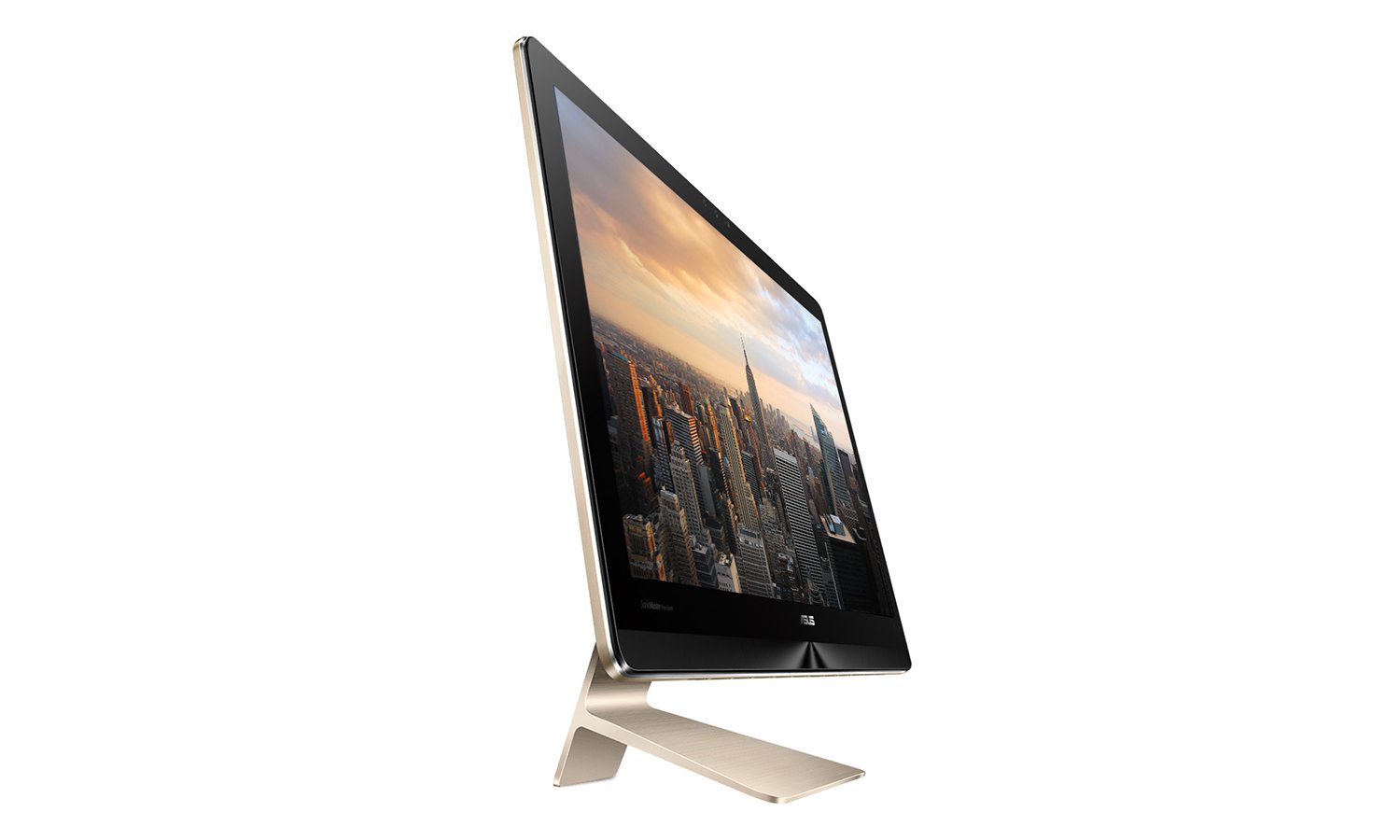
At 23 x 17 x 7.5 inches and 16 pounds, the Zen has an impressively small footprint, but it feels a bit too heavy to comfortably lug from room to room. Apple's 21.5-inch iMac is smaller and lighter, at 20.8 x 17.7 x 7 inches and 12.5 pounds, while MSI's 4K all-in-one, the 24GE, is a bit heftier, at 23 x 17 x 7.5 inches and 21 pounds.
MORE: Best All-in-One PCs
Ports
The Zen AiO is one of the first all-in-one PCs to sport a USB Type-C port, which allows for superspeedy connections to Type-C accessories, such as storage drives and select smartphones.
In addition to Type-C, the Zen packs four USB 3.0 ports, one USB 2.0 port, two HDMI connections, a 2-in-1 card reader, an Ethernet port, and headphone and microphone jacks. You won't be at a loss for ways to attach your accessories or extra displays.
My only gripe with the Zen's ports is that, just like on the iMac, they're all tucked away on the PC's rear panel. This helps the desktop maintain its sleek, seamless look, but also forces you to reach around or swivel the PC sideways every time you want to plug something in.
Get instant access to breaking news, the hottest reviews, great deals and helpful tips.
Display
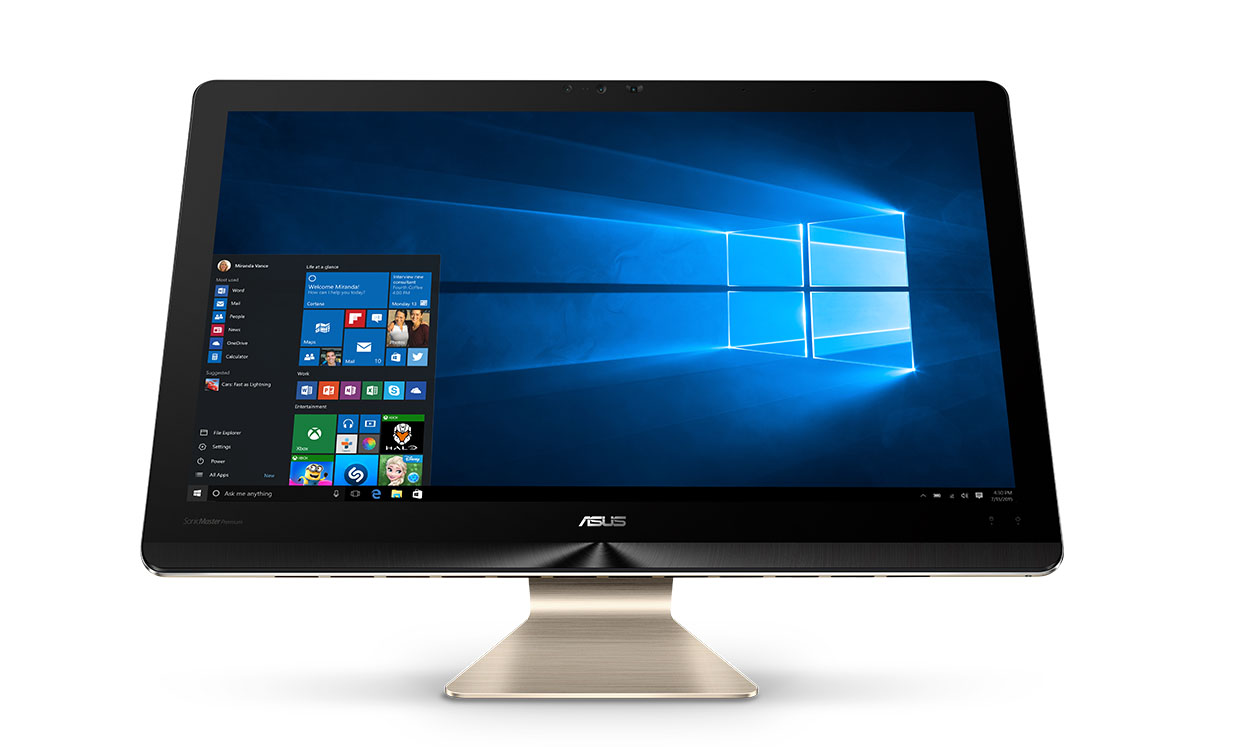
The Zen's 23.8-inch, 3840 x 2160 display impressed me immediately, from the way website text looked nearly handwritten to the bursts of color that popped out of the latest Star Wars: Episode VII - The Force Awakens poster.
A 4K trailer for Suicide Squad looked incredibly crisp.
A 4K trailer for Suicide Squad looked incredibly crisp — almost too crisp, in fact. I was able to spot the tiniest details, from the strands of Will Smith's beard to Killer Croc's facial scales; when it came time for the Joker's terrifying close-up, I felt like a deranged Jared Leto was standing right in front of me.
Despite its high picture quality, the Zen isn't quite the brightest all-in-one we've tested. Asus' PC measured 255 nits on our light meter, which beats out the MSI 24GE's 23.6-inch 4K display (239 nits) but falls behind the iMac's 21.5-inch supervibrant 1080p screen (424 nits) as well as our 274-nit all-in-one average.
On the other hand, the Zen's richness and color accuracy were backed up by our lab tests. The PC produced 99 percent of the sRGB color gamut, and exhibited an extra-accurate 0.21 on our Delta-E test (lower numbers are more accurate). The iMac exhibited gamut and Delta-E ratings of 109 percent and 2.9 respectively, while the MSI's registered 128 percent and was similarly color-accurate, at 0.29.
Unlike on the iMac, the Zen's display is fully touch-capable. While this will be more useful to some folks than others, I generally had an easy time navigating menus with finger taps and pinching to zoom in and out of websites on the PC's 10-point-multitouch display.
Audio
Packing stereo speakers with two woofers, the Zen delivers loud, impressively bass-heavy sound. When rocking to Fall Out Boy's "Irresistible," I could almost feel the impact of the kick drum and bass guitar, though the song's guitars and synths sounded thin by comparison.
I had a similar experience when watching the Star Wars: Episode VII - The Force Awakens trailer — the film's epic orchestral soundtrack sounded full, but the sound of blaster fire and spoken dialogue lacked sharpness.
The RealSense camera works reliably and simply makes the Zen more fun to use.
RealSense Webcam
The Zen AiO utilizes Intel's RealSense 3D camera, which supports a variety of neat 3D-scanning and motion-tracking apps. After using a handful of photo apps and gesture-controlled games with RealSense, I found that the camera works reliably and simply makes the Zen more fun to use.
I played with 3D Systems' Sense app, which lets you create a 3D scan of faces and objects, and was mostly impressed by how the Zen's webcam handled it.

While the camera missed a few spots of my head and created some pretty terrifying scans, it still did a good job of capturing the depth and detail of my nose, lips and eyes.
One of RealSense's key benefits is its ability to superimpose you onto a background without the need for a green screen. This feature worked fairly well in the Personify video chat app, though I did notice some details of the background behind me bleeding in.

RealSense works well as a gaming peripheral, as I discovered during my time with Lego Portal Racers. The game allows you to steer a car by tilting your head left and right, and grab virtual coins by lifting your arms. Despite how silly I must have looked to nearby co-workers, I found both gestures to be a surprisingly intuitive replacement to using a keyboard or gamepad.
The webcam also played nicely with Windows 10's Hello feature, which allows you to sign in to your machine using facial recognition alone. After registering my face with my account, I was able to unlock the PC within seconds by simply looking at it.
There are currently around 26 apps available for RealSense, with a mix of paid and free offerings that run the gamut from puzzle games to painting simulators. The camera won't necessarily be a system-seller for everyone, but it's certainly an entertaining extra.

RealSense features aside, the Zen's 1080p camera takes decent photos. I noticed some blurriness on my stubbly face, but my skin tone, clothing details and birthmarks looked accurate.
Performance

Armed with a 6th-generation 2.8-GHz Intel Core i7-6700T processor, the Zen AiO S powered through any combination of tasks I hurled at it. I never experienced any significant moments of slowdown, even when working in Google Docs, watching streams from YouTube and Twitch, and downloading a game to Steam all at once.
The Zen cranked out an impressive 12,986 on the Geekbench 3 overall performance test, edging out the Core i7-powered MSI 24GE (12,602), the Core i5-powered iMac (5,464) and our 6,596 all-in-one average.
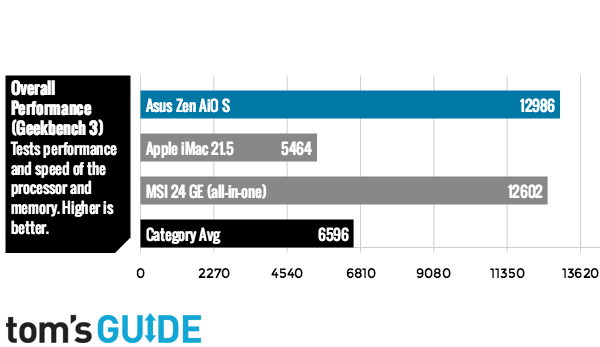
Asus' all-in-one matched 20,000 names to addresses in a breezy 3 minutes and 43 seconds, barely beating the MSI and iMac (both took 3:49) and besting the 7:17 average.
The Zen's 512GB SSD duplicated 4.97GB of mixed media in just 10 seconds, resulting in a blazing transfer rate of 508 MBps. That tops the MSI's still-impressive 2TB, 5,400-rpm hard drive (382 MBps), and trounces the 124-MBps average as well as the iMac's 500GB, 5,400-rpm hard drive (38.5 MBps, though faster flash storage options are available).
The Nvidia 960M GPU graphics smoothly rendered the frenetic firefights of Bioshock Infinite.
Graphics
Thanks to its Nvidia GeForce 960M GPU, the Zen can handle mainstream games without breaking much of a sweat — just don't expect to be doing much 4K gaming. The machine had no issues rendering the colorful airborne cities and frenetic firefights of Bioshock Infinite, even at higher graphics settings.

The Zen ran Infinite at a silky 107 frames per second at 1080p with the graphics set to low, and slowed to a still-playable 44 fps with the graphics on high. The GeForce 960M-powered MSI 24GE provided similar performance on high graphics (102 fps) but actually ran the game better on high (71 fps). While there's no 4K benchmark for Infinite, the game ran at up to 60 fps on low graphics at ultra-HD resolution, but crawled to a slideshowlike 15 fps on ultra graphics.
Asus' PC handled the more demanding Metro: Last Light at 1080p at a strong 78 fps on low graphics, but crawled to a sluggish 17 fps on high. When we kicked the resolution to 4K, the PC mustered a just-less-than-playable 24 fps on low, and a don't-even-bother 5 fps on high.

The Zen netted a 4,092 on the 3DMark Fire Strike benchmark, just barely surpassing the 24GE (4,008) while crushing our 1,321 all-in-one average.
MORE: Best Bluetooth Speakers
Mouse and Keyboard
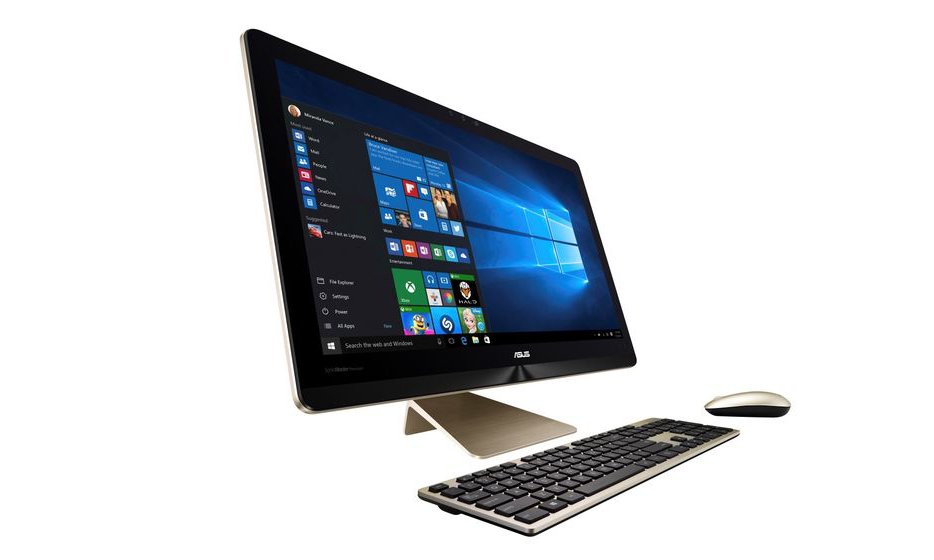
The Zen ships with a pretty standard-issue wireless keyboard and mouse combo, and the accessories get the job done. While I wished the keys were a bit snappier, Asus' keyboard allowed me to speed through the Key Hero typing test at 90 words per minute (I usually average around 80) with 97 percent accuracy. This may be attributed to the keys' somewhat deep travel of 2.3 millimeters combined with its more average 61-gram actuation (i.e., required force).
The included mouse is as vanilla as it gets, with two click buttons and a centered scroll wheel. I had no issues navigating Web pages accurately, and was pleased by the satisfying click that each button produced.
Configurations and the Competition
Our $1,899 Zen AiO Pro is the highest-end of the bunch, packing a 6th-gen Intel Core i7 processor, Nvidia GeForce GTX 960M graphics, 16GB of RAM and 512GB of flash storage. The PC starts at $999 with a 1080p display, Intel Core i5 processor, GTX 950M graphics, 8GB of RAM, a 1TB SSHD and no RealSense camera. The cheapest 4K model costs $1,499 and includes a Core i7 processor, GTX 960M graphics, 8GB of RAM, a 1TB SSHD and a RealSense camera.
Apple's 21.5-inch 4K iMac starts at $1,499, but configuring it with a comparable CPU, RAM and SSD would run you $2,399, and that's without discrete Nvidia graphics or a RealSense camera. Naturally, the iMac also ships with its own unique set of software via OS X El Capitan, so you'll have weigh to out whether Apple's operating system suits your needs better than Windows 10.
Bottom Line
The Asus Zen AiO Pro crams a ton of impressive features into one of the most attractive all-in-one designs available. Its gorgeous 4K display is ideal for work or play, as are its speedy 6th-gen Core i7 processor and discrete Nvidia 960M graphics. The machine also packs plenty of useful extras you won't find on many all-in-ones, including a RealSense 3D webcam and USB Type-C support.
If you rely heavily on Apple devices and software, the iMac's healthy app selection and seamless iOS integration still make it one of the best all-in-one desktops out there. However, if you're open to getting a Windows 10 machine, the Zen has a lot more functionality to offer than Apple's computer for the price.
Mike Andronico is Senior Writer at CNNUnderscored. He was formerly Managing Editor at Tom's Guide, where he wrote extensively on gaming, as well as running the show on the news front. When not at work, you can usually catch him playing Street Fighter, devouring Twitch streams and trying to convince people that Hawkeye is the best Avenger.


